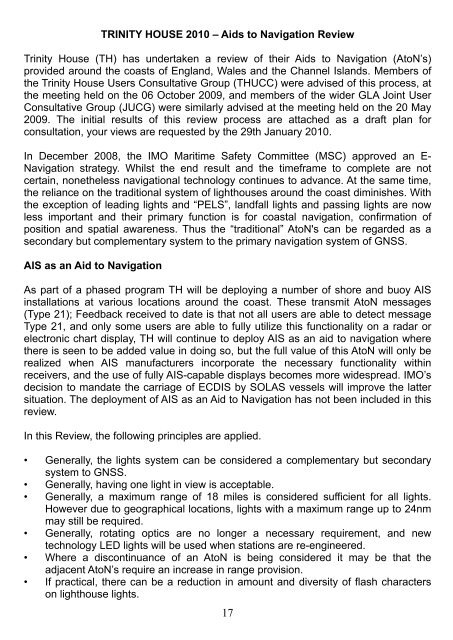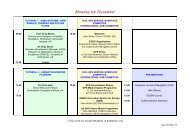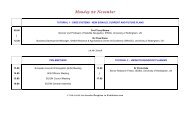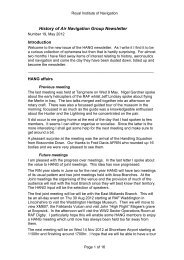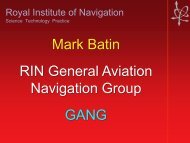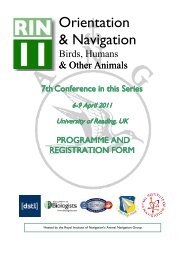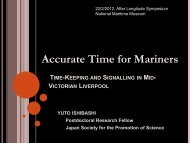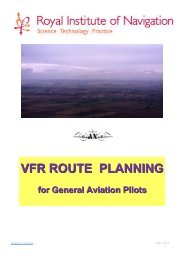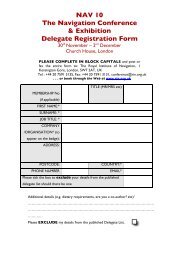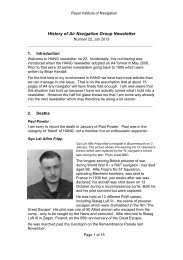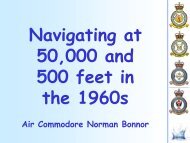Fairway 30 - Royal Institute of Navigation
Fairway 30 - Royal Institute of Navigation
Fairway 30 - Royal Institute of Navigation
Create successful ePaper yourself
Turn your PDF publications into a flip-book with our unique Google optimized e-Paper software.
TRINITY HOUSE 2010 – Aids to <strong>Navigation</strong> Review<br />
Trinity House (TH) has undertaken a review <strong>of</strong> their Aids to <strong>Navigation</strong> (AtoN’s)<br />
provided around the coasts <strong>of</strong> England, Wales and the Channel Islands. Members <strong>of</strong><br />
the Trinity House Users Consultative Group (THUCC) were advised <strong>of</strong> this process, at<br />
the meeting held on the 06 October 2009, and members <strong>of</strong> the wider GLA Joint User<br />
Consultative Group (JUCG) were similarly advised at the meeting held on the 20 May<br />
2009. The initial results <strong>of</strong> this review process are attached as a draft plan for<br />
consultation, your views are requested by the 29th January 2010.<br />
In December 2008, the IMO Maritime Safety Committee (MSC) approved an E-<br />
<strong>Navigation</strong> strategy. Whilst the end result and the timeframe to complete are not<br />
certain, nonetheless navigational technology continues to advance. At the same time,<br />
the reliance on the traditional system <strong>of</strong> lighthouses around the coast diminishes. With<br />
the exception <strong>of</strong> leading lights and “PELS”, landfall lights and passing lights are now<br />
less important and their primary function is for coastal navigation, confirmation <strong>of</strong><br />
position and spatial awareness. Thus the “traditional” AtoN's can be regarded as a<br />
secondary but complementary system to the primary navigation system <strong>of</strong> GNSS.<br />
AIS as an Aid to <strong>Navigation</strong><br />
As part <strong>of</strong> a phased program TH will be deploying a number <strong>of</strong> shore and buoy AIS<br />
installations at various locations around the coast. These transmit AtoN messages<br />
(Type 21); Feedback received to date is that not all users are able to detect message<br />
Type 21, and only some users are able to fully utilize this functionality on a radar or<br />
electronic chart display, TH will continue to deploy AIS as an aid to navigation where<br />
there is seen to be added value in doing so, but the full value <strong>of</strong> this AtoN will only be<br />
realized when AIS manufacturers incorporate the necessary functionality within<br />
receivers, and the use <strong>of</strong> fully AIS-capable displays becomes more widespread. IMO’s<br />
decision to mandate the carriage <strong>of</strong> ECDIS by SOLAS vessels will improve the latter<br />
situation. The deployment <strong>of</strong> AIS as an Aid to <strong>Navigation</strong> has not been included in this<br />
review.<br />
In this Review, the following principles are applied.<br />
• Generally, the lights system can be considered a complementary but secondary<br />
system to GNSS.<br />
• Generally, having one light in view is acceptable.<br />
• Generally, a maximum range <strong>of</strong> 18 miles is considered sufficient for all lights.<br />
However due to geographical locations, lights with a maximum range up to 24nm<br />
may still be required.<br />
• Generally, rotating optics are no longer a necessary requirement, and new<br />
technology LED lights will be used when stations are re-engineered.<br />
• Where a discontinuance <strong>of</strong> an AtoN is being considered it may be that the<br />
adjacent AtoN’s require an increase in range provision.<br />
• If practical, there can be a reduction in amount and diversity <strong>of</strong> flash characters<br />
on lighthouse lights.<br />
17


